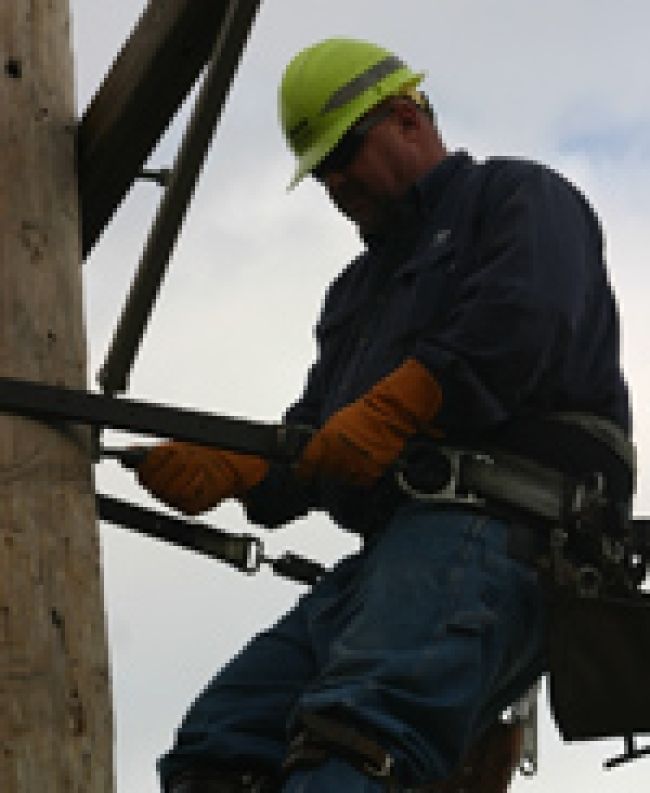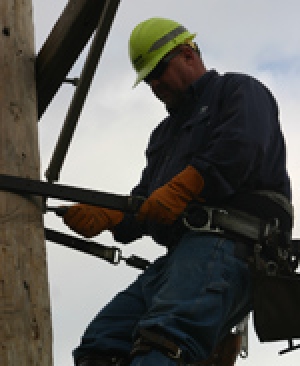
Ergonomics for Lineworkers

I am not an ergonomics expert. I am, however, a former lineman now in my 50s, experiencing aches and pains from many years of working in the field. I became interested in how ergonomics – the field of study that fits the job to the worker rather than the worker to the job – could improve line work after reading an article that explained how We Energies, an electric service provider headquartered in Milwaukee, had conducted a study in conjunction with the Electric Power Research Institute and Marquette University to determine why their employees were suffering so many hand, shoulder, knee and back injuries. It was like a light bulb came on. I thought back to co-workers who struggled with chronic pain resulting from their work as lineworkers and realized it didn’t have to be that way. I started the trade knowing it was a hard job, but I was young and strong. I wanted to impress co-workers and gain their acceptance on the crew, so I worked hard and didn’t concern myself with what I was doing to my body. The veterans who started this same way, and were now suffering the consequences, respected others who were willing to put in the hard work and sacrifice themselves just like they did.
I started my career as a lineman for ComEd, an electric utility serving the Chicago area, in 1985. At that time, three- and four-man crews were still common. The senior lineworkers and crew leaders served more as coaches; their roles involved planning, laying out the work, observing and teaching the younger lineworkers while completing necessary paperwork. They had a wealth of knowledge and experience, but the years of line work in the days when brute force was what got the job done took their toll. The profession was a young man’s game, and the badge of honor was a body worn out from years of hard work – climbing poles, pulling up crossarms, lifting wire, and digging pole holes and splice pits by hand. When work practices and equipment were improved, I can remember lineworkers remarking how it seemed the industry was trying to make line work so easy that women or children could do it. It was a man’s trade and we were very proud of that because few could do the work and ever fewer could excel. Unfortunately, this culture is still prevalent in the trade today and unless lineworkers change their mindset, their bodies will continue to be worn down. The industry has made huge strides in developing work practices that have improved the safety of workers. However, as the workforce continues to age, ergonomic injuries are piling up at many utilities. Companies are experiencing increases in medical and workers’ compensation costs and a loss of valuable, experienced workers on job sites. Additionally, workers’ quality of life is being compromised as they approach retirement age due to the damage done to their bodies throughout their careers.
Industry Shift
Around 1990 the industry started to shift to two-man crews. About the same time, lineworkers started to see advances in the equipment used in power line construction and maintenance. Working with better equipment allowed fewer crew members to be more efficient. However, that culture of sacrificing our bodies to get the job done still existed, and training didn’t address how to accomplish the work while subjecting the body to less stress. The closest we came to being ergonomic back then was trying to follow the “work smarter, not harder” phrase coined in the 1930s by Allan Mogensen, an industrial engineer and authority in the in the field of work simplification. Mogensen’s concepts were essentially ergonomics ahead of its time. He designed processes and work spaces that minimized movement and job steps, which resulted in less stress to the worker’s body and increased production. The byproduct of these improved processes was a decrease in musculoskeletal disorders (MSD), many of which had not even been identified back then. MSDs are also known as cumulative trauma disorders or repetitive strain injuries. They affect the soft tissues of the body including muscles, tendons and ligaments. When lineworkers overwork or overstrain their bodies, these soft tissues are prone to injury. The most common areas of injury are knees, lower back, shoulders and hands. In the beginning they are sore after a day of particularly hard work, but it is usually chalked up to hard work, not working incorrectly. Consequently, work practices don’t change and the worker periodically reinjures the soft tissue until the injury becomes chronic. At that point, medical care including physical therapy and possibly even surgery are required to correct the damage, and chances are good that injured workers will experience some level of diminished movement or strength.
I don’t remember hearing about ergonomics when I was a lineworker. As I mentioned earlier in this article, ergonomics is the field of study that fits the job to the worker rather than the worker to the job. This fit is achieved through the evaluation and design of workplaces, environments, job tasks, equipment and processes in relationship to human capabilities and interactions in the workplace. It is more difficult to accomplish when the work and workplace are constantly changing as is the case in the transmission and distribution industry.
Employer Considerations
Employers typically think ergonomics means spending money on tools and equipment to make their employees’ jobs easier. That is part of the answer, but should not be the only effort made to decrease MSDs. The real key to improving worker ergonomics and reducing MSDs is educating employees about risk factors and how to make better choices in the field. Risk factors depend upon duration of exposure, frequency of exposure, intensity of exposure and combinations of these risk factors. Ergonomic exposure hazards fall into two categories: overuse and overexertion. I refer to these as exposures because the MSDs don’t stem from one particular incident – they occur from micro-injuries that happen over a long period of time.
Following are some examples of typical lineworker job tasks that involve risk factors:
• Work with repetitive movements.
• Work that places the upper body in the same posture or an uncomfortable position for extended periods of time.
• Work that requires force.
• Physically heavy work.
Lineworkers experience these exposures on a regular basis because safe work practices place them below energized equipment and conductors. In these situations, the electrical hazards outweigh the ergonomic hazards. When reaching up in cramped work spaces, the body is placed in awkward positions with the requirement to exert force; these are all examples of risk factors. This also is an example of how exposures can be combinations of risk factors, which make it more likely an MSD will result over time.
Stretching and conditioning programs are another avenue utilities are taking to battle MSDs. Workers who have hard physical jobs are industrial athletes – not athletes competing in games, but athletes trying to complete tasks that at times can take them to their physical limits. You will never see an NFL player come out of the tunnel and go immediately into a game without stretching. That is because they and their coaches realize doing so would mean almost certain injury. By stretching each morning, and by also teaching employees how to stretch on the job site for the particularly difficult physical tasks they are doing at the time, MSD injuries can be reduced. Working in colder climates can also increase the likelihood of MSDs because muscles tend to be cold and tight and workers attempt to complete hard physical tasks while wearing heavy clothing. By stretching before the workday begins, or before hard physical labor, the worker warms up muscles and lubricates tendons and ligaments so that they are less likely to be injured when used.
A Challenge to Workers
When educating lineworkers about ergonomic hazards, I challenge them to recognize when they are in work postures that fall into these exposures, and to then determine the risk of the exposure to cause injury. If they don’t recognize poor postures while performing the work, they must listen to their bodies when they hurt, identify the cause of the pain, assess if there is a way to minimize the exposure and make the appropriate work practice changes needed to prevent the injury from happening again. It’s also important for them to determine if they can change postures, use different tools or use equipment to reduce the risk factors. Notice I didn’t say this would make things easier. It is very possible that getting the proper tool or equipment will not be convenient and will take longer. This is often when workers will “muscle” the work and overexert or overextend their bodies. These are shortcuts very similar to unsafe work practices that expose workers to increased hazards.
Any changes an employee can make must be done while still maintaining safe work practices. Workers who simply change their work position, use a different tool or use equipment to do the work instead of sacrificing their bodies can significantly reduce the chance that they will suffer soft tissue injuries. For example, when a lineworker needs to expose cable by digging, they need to first determine where to throw the dirt so that, while digging, they are not twisting while lifting and throwing the dirt. These are both risk factors in addition to the repetitive motion. The lineworker also needs to figure out if it is practical to use excavation equipment such as backhoes, mini excavators or vacuum excavators to minimize exposure. This requires assessing the work to be done that day and choosing to bring the correct equipment with them before they leave the shop. With this type of preplanning, it is likelier the crew will work more ergonomically.
Anyone can “bull” the work and “get ’er done,” but someone who works smarter can work longer, accomplishing more with less pain over time. I challenge all lineworkers to work smarter, not harder. This does not mean they should be lazy; it means they should use skills, techniques and available equipment to make work easier on their bodies. I also challenge all employers to provide their employees with the tools and equipment that allow work to be done efficiently while improving ergonomics.
About the Author: Steve Hedden, CUSP, is job training and safety instructor for Municipal Electric Utilities of Wisconsin and the founder of Safely Home Utility Training Services. To find out more about how ergonomics can benefit lineworkers, join Hedden when he presents “Ergonomics for Lineworkers” September 30 at the iP Utility Safety Conference & Expo in Louisville, Ky.

